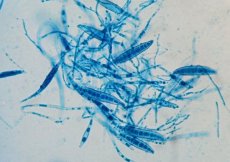Medical expert of the article
New publications
Microsporia pathogens (Microsporum)
Last reviewed: 04.07.2025

All iLive content is medically reviewed or fact checked to ensure as much factual accuracy as possible.
We have strict sourcing guidelines and only link to reputable media sites, academic research institutions and, whenever possible, medically peer reviewed studies. Note that the numbers in parentheses ([1], [2], etc.) are clickable links to these studies.
If you feel that any of our content is inaccurate, out-of-date, or otherwise questionable, please select it and press Ctrl + Enter.

Microsporia (synonym: ringworm) is a highly contagious skin disease, mainly in children, caused by fungi of the genus Microsporum. A distinction is made between microsporia of the scalp and microsporia of the smooth skin. The scalp (skin,hair ) is predominantly affected, and nails are rarely affected. Muffs or sheaths of mosaically arranged spores (of the "ecto- and endofungus" type) form around the hair. The source of the disease can be people, animals, and soil.
The causative agent of zoonotic and microsporic M. canis causes disease in cats, dogs and humans. Fungi are often asymptomatic in the skin of animals. The incubation period is 5-7 days. Pure culture of the fungus consists of septate mycelium, rounded chlamydospores and thick-walled multicellular spindle-shaped macroconidia with spines.
The causative agents of anthroponotic microsporia M. audouinii, M. ferrugineum affect almost only humans. The incubation period is 4-6 weeks. A pure culture of M. audouinii consists of a wide (4-5 μm) septate mycelium, chlamydospores (diameter about 30 μm) and arthrospores. Macro- and microconidia are rare. A pure culture of M. ferrugineum is represented by a branched septate mycelium, arthrospores and chlamydospores.
Geophiles (M cookei, M fulvum, M nanur) live in the soil and are transmitted by contact with it. For example, Microsporum gypseum is transmitted by soil cultivation with bare hands, causing gardeners' microsporia. M gypseum causes a purulent-inflammatory process of the scalp (kerion), ending after 8 weeks with moderate scarring.


 [
[